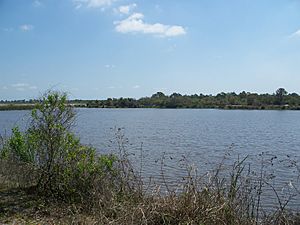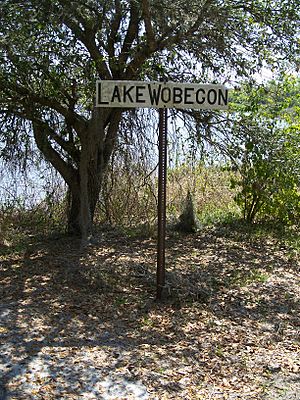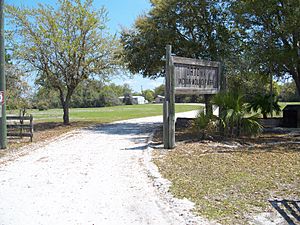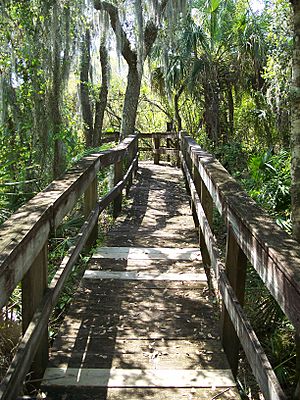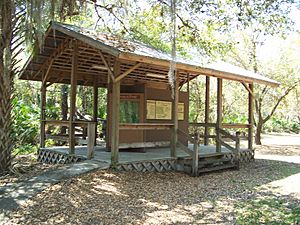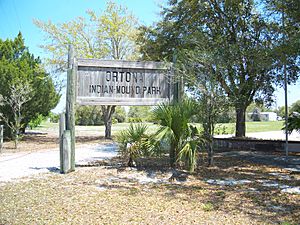Ortona, Glades County, Florida facts for kids
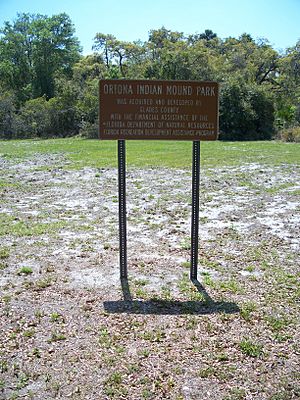
Ortona is a small community in Glades County, Florida. It's not a city with its own government, but a place where people live.
One cool spot in Ortona is the Indian Mound Park. This park protects part of the Ortona Prehistoric Village. You can explore hiking trails there. Long ago, Native Americans built large mounds, canals for canoes, and other earthworks in this area. These amazing structures cover about five square miles along the Caloosahatchee River. You can find the park on SR 78, north of LaBelle.
Contents
History of Ortona
Early Days and Settlers
Back in 1924, a businessman named Jerome G. Attanasio bought a lot of land near Citrus Center. He named his new community "Ortona" after his hometown in Italy. He hoped to attract people who grew grapes. He even reported that his own grape plants were growing well!
At first, some people who didn't own land, called "squatters," lived in Ortona for a while. They would move in and out of the area. After a tough time called the Great Depression, most land developers left. Only a few families stayed, like the Williams, Storter, Hicks, Komer, and Rivers families.
Later, more settlers came to Ortona, especially along the Caloosahatchee River. They built their homes using natural materials. They used cane poles for the walls and large palm leaves, called "cabbage fan palms," for the roofs. These palm roofs could last up to three years! Everyone in the community helped each other build their houses.
Community Life
The early settlers lived closely together. They fished, hunted, and farmed as a group. Everyone had access to sugarcane, which they used to make syrup. Neighbors helped each other grind the cane. Even though they worked together, they still had to buy their own tools and supplies.
One family, Tom and Amanda Williams, brought their grandson Vance Storter to Ortona when he was four. They had traveled from Naples after their daughter passed away. They even bought hogs from the Seminole people before settling in Ortona.
Schools and Learning
The first school in Ortona was near a saw mill. Later, the county built a bigger school on two acres of land. This new school was needed because more children were moving to the area.
Teachers sometimes found it hard to stay. One even left because of a "nervous breakdown." But a teacher named "Mr. Ketring" was very good at keeping the boys focused on their schoolwork. It was tough for students to concentrate on books when there was so much hunting, fishing, and chores to do!
Work and Resources
Steamboats from Fort Myers would come to Ortona to pick up "cordwood." The J.F. "Bud" Cross family would cut down trees and deliver the wood to the boats.
There was a special spot called Coffee Mill Hammock. People would grind their coffee beans using a mill nailed to a tree. Everyone could use it! This area, and a road nearby, were named after the coffee mill.
In the 1920s, there were no laws about fencing in cows. This meant cows roamed freely. If you were determined, you could get free milk! People used a "drawdy pole" to milk the cows. This was a long pole with a rope loop. They would hook the loop around a cow's horns and twist the pole to hold the cow still. Then they could milk it.
The cows were "free-range," meaning they ate whatever they found. A family could get enough milk from about 14 to 20 cows. They had "sweet milk" for drinking and "sour milk" for baking bread. They also made butter and other dairy products.
People also raised hogs and sold them to locals or took them to Fort Myers. Hogs were more valuable than cattle back then because the cattle were often too thin.
Community Places
The Ortona Cemetery was started in 1921 on 32 acres of land. Clive Hicks was the first person to take care of it.
A train depot was built after a railroad crossing, called Chihi, was finished. The first person to operate the bridge for the railroad was Eugene Walker. He even bought a cane mill from someone for $112! The train depot was also a safe place for people to go during floods.
Today, Ortona has some modern businesses. Meadowlark Campground, which used to have a two-story building for workers, is now called Meadowlark Shores 55+ RV Park. Ken Bracken also started a neighborhood called River Oaks, west of Meadowlark Shores.
Turkey Creek was created by Eugene Walker. This is where O'Bannion's saw mill was located. They even had a "dragline" machine there, which could dig through thick brush where a horse couldn't go.
In 1985, there were sandmines in Ortona. Also, Paul and Wheeler planted 1,000 acres of young citrus groves in 1979. At that time, Ortona also had a beauty shop, a store, and a bar for locals and visitors.
Climate
| Climate data for Ortona, Florida, 1991–2020 normals, extremes 2002–present | |||||||||||||
|---|---|---|---|---|---|---|---|---|---|---|---|---|---|
| Month | Jan | Feb | Mar | Apr | May | Jun | Jul | Aug | Sep | Oct | Nov | Dec | Year |
| Record high °F (°C) | 88 (31) |
91 (33) |
93 (34) |
98 (37) |
101 (38) |
100 (38) |
98 (37) |
98 (37) |
96 (36) |
95 (35) |
93 (34) |
89 (32) |
101 (38) |
| Mean maximum °F (°C) | 85.8 (29.9) |
87.2 (30.7) |
88.9 (31.6) |
92.7 (33.7) |
94.2 (34.6) |
96.0 (35.6) |
95.5 (35.3) |
95.6 (35.3) |
94.4 (34.7) |
92.6 (33.7) |
88.5 (31.4) |
86.2 (30.1) |
96.8 (36.0) |
| Mean daily maximum °F (°C) | 74.2 (23.4) |
77.9 (25.5) |
80.4 (26.9) |
84.9 (29.4) |
88.2 (31.2) |
90.1 (32.3) |
90.9 (32.7) |
91.6 (33.1) |
89.5 (31.9) |
85.8 (29.9) |
80.1 (26.7) |
76.7 (24.8) |
84.2 (29.0) |
| Daily mean °F (°C) | 61.7 (16.5) |
64.7 (18.2) |
67.5 (19.7) |
72.3 (22.4) |
76.5 (24.7) |
80.0 (26.7) |
81.4 (27.4) |
82.1 (27.8) |
80.4 (26.9) |
75.9 (24.4) |
69.1 (20.6) |
64.6 (18.1) |
73.0 (22.8) |
| Mean daily minimum °F (°C) | 49.2 (9.6) |
51.5 (10.8) |
54.6 (12.6) |
59.8 (15.4) |
64.7 (18.2) |
70.0 (21.1) |
72.0 (22.2) |
72.5 (22.5) |
71.4 (21.9) |
66.0 (18.9) |
58.2 (14.6) |
52.6 (11.4) |
61.9 (16.6) |
| Mean minimum °F (°C) | 32.1 (0.1) |
35.7 (2.1) |
39.5 (4.2) |
47.9 (8.8) |
56.7 (13.7) |
66.2 (19.0) |
68.3 (20.2) |
69.9 (21.1) |
67.5 (19.7) |
53.1 (11.7) |
42.8 (6.0) |
39.0 (3.9) |
30.3 (−0.9) |
| Record low °F (°C) | 25 (−4) |
26 (−3) |
32 (0) |
42 (6) |
51 (11) |
60 (16) |
61 (16) |
67 (19) |
62 (17) |
40 (4) |
37 (3) |
26 (−3) |
25 (−4) |
| Average precipitation inches (mm) | 2.21 (56) |
1.92 (49) |
2.83 (72) |
3.06 (78) |
4.62 (117) |
10.31 (262) |
9.04 (230) |
9.15 (232) |
7.47 (190) |
3.34 (85) |
1.34 (34) |
1.77 (45) |
57.06 (1,449) |
| Average precipitation days (≥ 0.01 in) | 5.6 | 5.7 | 5.1 | 5.9 | 9.0 | 17.2 | 17.1 | 19.7 | 15.8 | 7.2 | 5.1 | 5.8 | 119.2 |
| Source 1: NOAA | |||||||||||||
| Source 2: National Weather Service (mean maxima/minima 2006–2020) | |||||||||||||
Communities
- Meadowlark Shores 55+ RV Park
- River Oaks Subdivision
- Turkey Creek
Festivals
Cane Grinding Festival
The Cane Grinding Festival is a special event in Ortona. It helps raise money for the local volunteer fire department. The community even helped build the firehouse!
This festival celebrates how early settlers grew and processed sugarcane to make tasty syrup. You can enjoy bluegrass music and watch clogging, a type of folk dance. There are also arts and crafts booths, and delicious barbecue chicken and rib dinners. All the money raised helps support the local fire department.


